

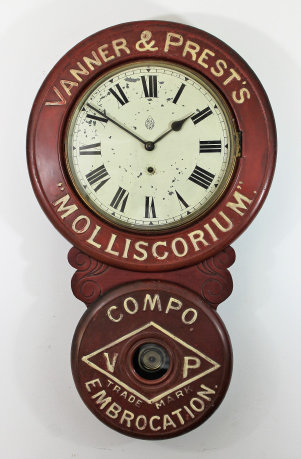
358. $425
British United Clock Co. “Vanner & Prest’s” advertiser, 1885-1909. This is NOT the Baird
advertiser you might think. The B.U.C.C. was in operation from 1885 to 1909 and modeled this clock after the more common Baird
advertisers for this leather treatment (Molliscorium). You can still buy Vanner & Prest horse care products today. It differs from the Baird clock in that the raised lettering is pressed into a tin cover over the wood bezels, rather than being formed
of paper maché. The clock is 30.5 inches long with an 11-inch dial that is flaking badly, but retains the BUCC logo. The
paint on the tin covers and case is in very good shape. The 8-day time-only signed movement is running and keeping time. No label, other than instructions on the back. These clocks are not common and I could not find a listing in the Antique Clocks
Price Guide. A nice complement to the Baird Vanner & Prest advertiser if you happen to have it. $500-$800.
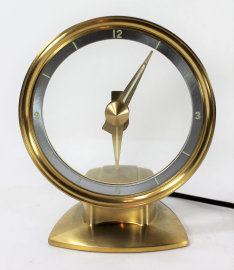
359. $50
Jefferson Electric Co. “Golden Minute” 1950’s. The little brother to the Golden Hour, this electric
mystery clock is 7.25 inches high and 6 inches wide in the same gold-plated zinc alloy. Some of the gold finish has been worn
off this clock but it still looks pretty good. The clock is running quietly and keeping time. $50-$90.
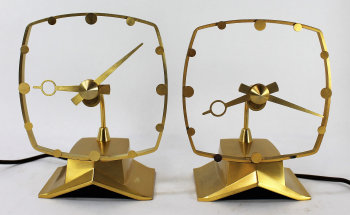
360. $50
Jefferson Electric Co. “Golden Secret”, 1950’s. These two mystery clocks differ from those that
contain a rotating glass disk; they use a cable that runs through the tube from the back of the base to the hands in the center of
the ring. There is no glass. These clocks tend to run slow, and these are no exception; both lose 5-10 min or so a day. The finish shows some spotting on the one on the right and there is a missing hour button at 5 o’clock, and the 7 o’clock button is
a poor replacement; the one on the left has a slight mar on the right side of the base, but it is not very noticeable. They
stand 7.25 inches high and 5.75 inches wide. Motors for these clocks are not readily available, but occasionally an eBay seller
will list refurbished motors. These guys typically bring $50-$60 apiece on eBay, but can sell for over $100 when in excellent
shape.
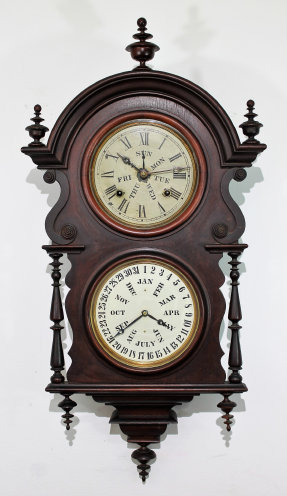
363. $1100
Welch, Spring & Co. “Wagner, Hanging, B.W.”, 1877-1884. We had the mantel version of this
double-dial calendar in our January auction; here is the equally uncommon wall version. It’s about 31 inches tip-to-tip,
with 7-inch dials. Both dials are painted, the upper showing some chipping and soiling; both glasses appear to be original. The hands are either original or close matches to those shown in the catalog illustrations (pages 194-195 of Ly’s second edition ofWelch Clocks). The finials also match the illustrations, but I wouldn’t guarantee that all are original. The case appears
to be mahogany and has a very old and possibly original finish. The temptation to clean it probably should be resisted. There is black flocking inside but no label; the back has padding on it and I could not see behind well enough to see if there was
a label. The 8-day time-and-strike movement is unsigned but clearly of Welch origin; the clock is running, keeping time, and
the weekday hand is advancing, but the lift bar for the lower dial is not triggering a date change and will need to be adjusted. Few sales in the Antique Clocks Price Guide, none recent. $1200-$1500.
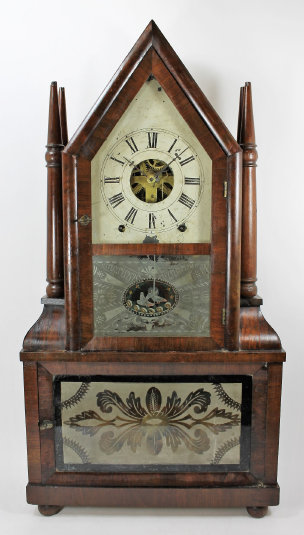
364. $1000
Birge & Fuller four-candlestick double steeple fusee, 1844-1848. These two had a successful
business until Thomas Fuller died. Candlestick double-steeple fusees from these two are relatively uncommon: In the Antique
Clocks Price Guide I count 16 candlestick double-steeples that used wagon-springs for power and only two that used a remote fusee,
as found here. This clock is as original as the day is long – All three glasses, the painted metal dial, both hands, and the
signed 8-day, time-and-strike movement. The glasses are in good condition considering their age; the dial shows some soiling
and some chipping. There is a good label. There is some missing veneer along the sides of the base, and the left candlestick
plinth is split at the seam, but these are not serious detriments to the clock. The candlesticks look original, but possibly
-possibly- one is a replacement. The clock is running and keeping time. If you want original and rare, here it is. The two comparable sales in the Antique Clocks Price Guide were for $2400 and $2500 at R.O. Schmitt’s in 2008 and 2014.
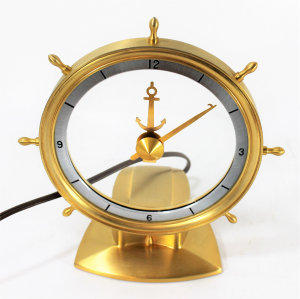
361. $100
Jefferson Electric Co. “Golden Helm”, 1953. About the same size as the Golden Minute
and also uses a silver chapter ring, but the lettering on the ring is black rather than white. It also uses the same motor. It stands 8 inches high and has an anchor and sailor’s hook as hands, inside a ship’s wheel. The finish on this clock is excellent. We replaced the motor and power cord, and it is running and keeping time, ready for service. Ahoy! $100-$150.
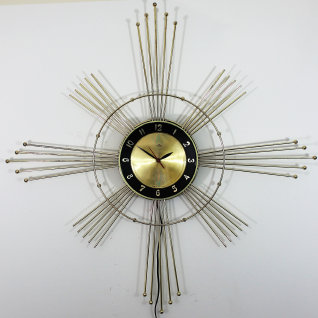
362. $60
Lux starburst electric wall clock, 1950’s. Get your mid-century modern on right here, starting
with a mid-century wall clock right out of your mom’s kitchen or dining room. Add a Jefferson mystery clock and you’ll have
it all. This clock is 28 inches in diameter with a 7-inch dial. The power cord is original and it is running. The
gold plating on the arms is good but not perfect. The plastic body and dial show little wear. Lux on the dial and Robert
Shaw-Fulton Controls Company on the back. No model number. $60-$100.